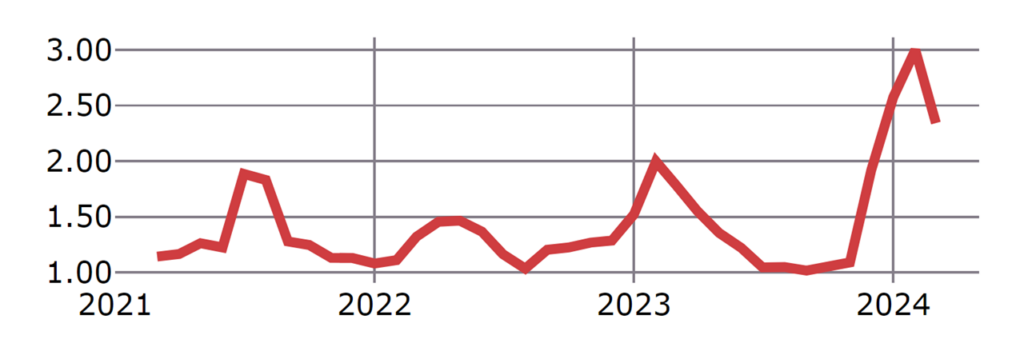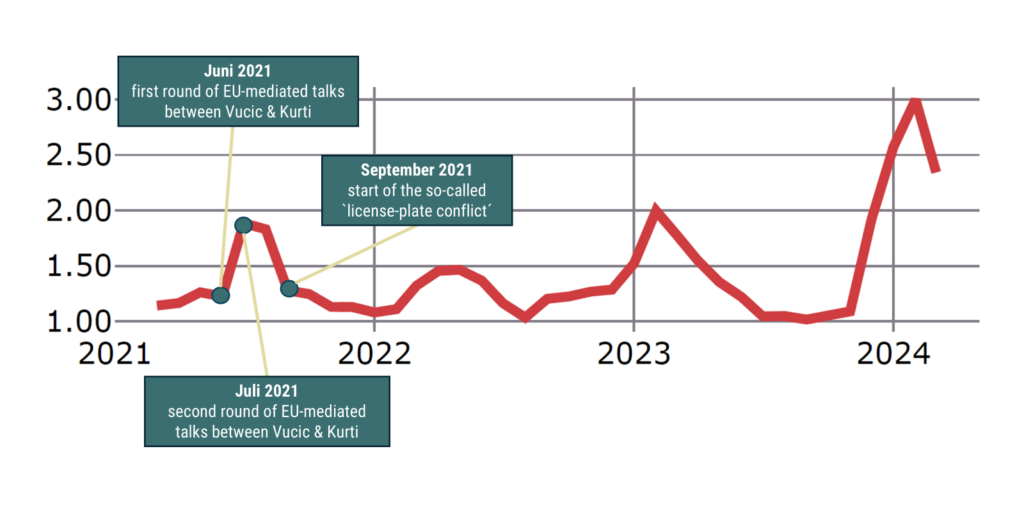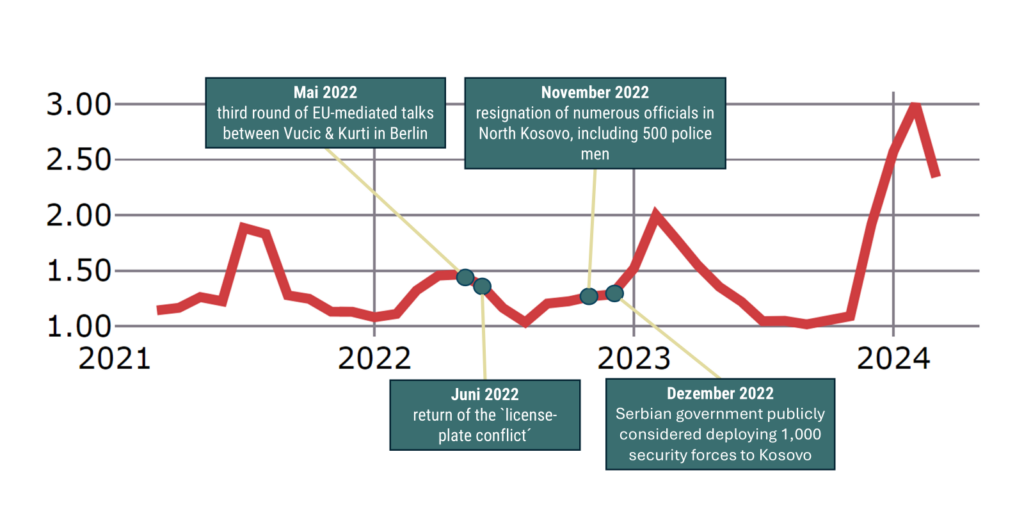The warning signal and the Kosovo-Serbia Conflict
The HTI provides for a warning signal. It indicates the development of the hybrid threat potential in a particular country. If the curve rises, the likelihood of hybrid attacks increases. The underlying assumption is that hybrid aggressors prepare their attacks during a priming phase by deliberately increasing complexity. The HTI can measure this increase and thus provide early warning signs for impending hybrid attacks.

The applicability of the warning signal is exemplified by the conflict development between Kosovo and Serbia from early 2021 to the end of 2023. At the core of this conflict is Serbia’s non-recognition of Kosovo’s independence and the situation of the Serbian minority in northern Kosovo. Additionally, it plays a crucial role in the political stability of the entire Western Balkans. For Russia, undermining the Belgrade-Pristina dialogue and fueling this conflict serves to tie up the diplomatic and military resources of Western states and to thwart a prospective EU membership of the involved parties.
The HTI’s warning signal indicates an increase in the potential for new hybrid attacks in the summer of 2021, as well as in the spring and winter of 2022. The threat potential also increases drastically at the end of 2023. To link the development of the measured signal with the actual conflict dynamics, we tracked the latter using various regional news portals, gray literature, and the Crisis Watch-Tracker of the International Crisis Group (ICG), and then cross-referenced them. The result: the warning signal consistently reaches temporary peaks shortly before confrontations on Kosovar soil intensify.
2021

In the spring of 2021, the left-nationalist party Levvizja Vetevendosje! (LVV, English: Movement for Self-Determination), led by Albin Kurti, achieved a landslide victory in the early parliamentary elections in Kosovo (CSIS 2021), thereby displacing the parties established since the declaration of independence in 2008. On election night, Kurti announced his willingness to engage in dialogue with Serbia, but stated he would no longer conduct it to Kosovo’s detriment. Additionally, his government has a strong interest in the EU accession process, which requires the normalisation of Serbian-Kosovar relations (FNS 2021).
Both parties actively participated in the Belgrade-Pristina dialogue again during this period, which had been reignited by EU Special Representative Miroslav Lajcak at the end of 2020 after a long stalemate (Clingendahl 2022).In June and July 2021, the first two official meetings between Serbian President Vucic and Kosovar Prime Minister Kurti took place (Balkan Insights 2021a, Balkan Insights 2021b). The warning indicator shows that, parallel to these negotiations, the potential for hybrid events increased, indicating priming. However, due to the border conflict that erupted in September 2021 over the recognition of Serbian license plates and identification documents, these negotiations have thus far been inconclusive (European Parliamentary Research Service 2023).
So what happened here? After the declaration of independence in 2008, Kosovar authorities began issuing their own license plates, marked with RKS (“Republic of Kosovo”). The previously-issued Serbian plates were marked with KS (“Kosovo”), emphasising the non-recognition of the former province. For a long time, the Kosovar government accepted the use of these old plates. But on 20 September 2021, it announced it would no longer recognise these plates, mirroring the Serbian government’s stance, which has not recognised Kosovar plates since the end of the Kosovo War (Balkan Insight 2023).
The Kosovar government’s decision led to fierce protests by the Serbian minority in northern Kosovo and along the Serbia-Kosovo border. The escalation potential was further fueled by the blockade of the border crossings at Jarinje and Brnjak, as well as border-proximate flight exercises by Serbian fighter jets and the alert status of Serbian police and armed forces. Despite a temporary agreement in October, the situation in northern Kosovo remained tense as violent clashes between Serbian protesters and Kosovar police forces repeatedly occurred (ICG 2024). This destabilisation phase is reflected in the warning indicator by a decrease and subsequent stabilisation of the curve at a relatively low level.
2022

The threat potential also increased in the third round of talks, which took place in Berlin in May 2022 following a temporary agreement in the license plate conflict (Balkan Insight 2022a). After a brief cooldown, the conflict flared up again starting in June 2022, with regular violent protests in northern Kosovo and clashes between police and protesters. After the coordinated resignation of numerous officials from the Srpska Lista party and over 500 police officers, the four regions with a Serbian majority—Mitrovica, Zvecan, Leposavic, and Zubin Potok—went without local police forces (Balkan Insight 2022b). ). The crisis reached its rhetorical peak in December 2022, when the Serbian government publicly considered deploying 1,000 security forces to Kosovar territory based on UN Security Council Resolution 1244 (Balkan Insight 2022c). The development of the warning indicator during this renewed destabilisation phase corresponds to our conceptual expectations.
2023

Despite the ongoing confrontations, the diplomatic efforts of Western and European partners resulted in a February 2023 agreement between the two parties on a normalisation plan (Balkan Insight 2023a). Vucic and Kurti verbally agreed on how eleven points proposed by the EU should be implemented in the so-called Ohrid Agreement (Balkan Insight 2023b). However, this rapprochement towards a negotiated solution was followed by the destabilisation of the situation in northern Kosovo, so its implementation has not yet occurred (Balkan Insight 2023c).For example, in May 2023, several soldiers of the NATO peacekeeping force KFOR and 50 Kosovo-Serbian demonstrators were injured in protests against the newly appointed Kosovo-Albanian mayors in the Zvecan region (Balkan Insight 2023d). In September of that year, a Kosovo-Serbian group killed a police officer during the siege of an Orthodox monastery (Balkan Insight 2023e).
What do we learn from this?
What does the analysis of this pilot study say about the potential of the HTI and its warning indicator? The answer to this question lies in what the warning indicator actually shows – and what it does not show. First of all, it indicates the level of complexity a state is facing. According to the HTI methodology, this complexity arises when atypical instruments are used in atypical constellations . The more atypical, the more complex, and the greater the potential for hybrid events. Increased complexity makes it difficult for a targeted state to identify, analyse, and respond to hybrid events.
Due to the geopolitical significance of the Western Balkans in general and the conflict between Kosovo and Serbia in particular, it seems likely that international actors would want to influence this conflict. The assumption that the Russian state, for instance, has an interest in deliberately disrupting the normalisation process between the conflict parties also appears plausible. The trajectory of the warning indicator suggests that this is indeed likely. In all three observed years, an increase in the threat potential coincides with the phases during which both sides engage in high-level diplomatic talks.
However, two central limitations must be considered. First, in its current version, the HTI measures the hybrid threat situation of a specific state at a specific point in time based on specific events. So far, it does not differentiate who is creating the threat situation. Therefore, a clear statement about whether and to what extent the increase in the threat potential is actually attributable to a specific actor’s behaviour, e.g. the Russian government, cannot be made solely on the basis of the data considered by the HTI. Second, the conflict events that the HTI is supposed to explain are themselves part of its measurement. This means that part of the abstract warning indicator dynamics also reflects the real-world conflict dynamics. From a theoretical perspective, the increase in complexity (and thus the measured threat potential) could also be based on the fact that the two long-standing conflict parties are atypically seeking a negotiated solution through diplomatic talks. This constellation also generates complexity, albeit perhaps in a less strategically-calculated manner than assumed by the HTI.

